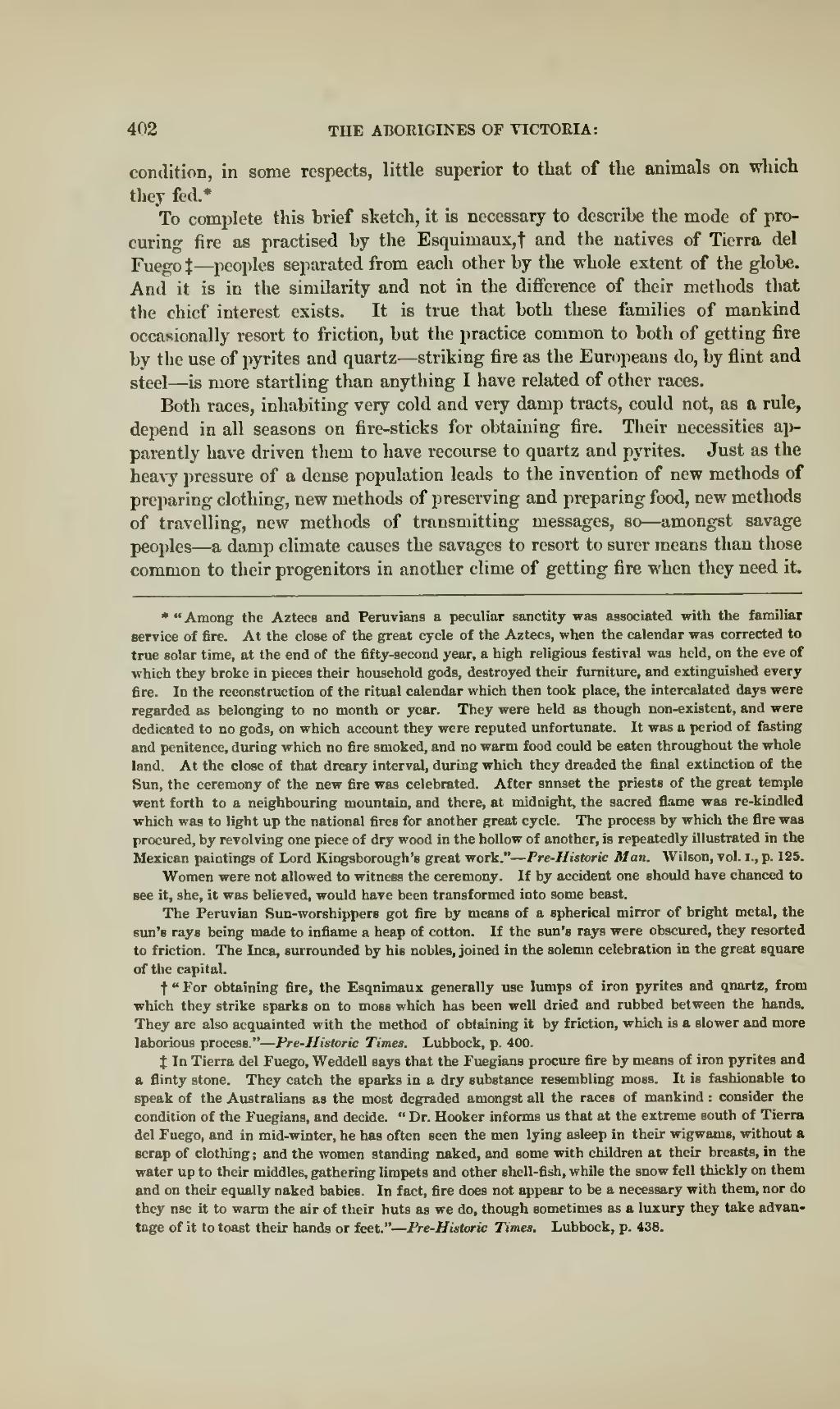condition, in some respects, little superior to that of the animals on which they fed.[1]
To complete this brief sketch, it is necessary to describe the mode of procuring fire as practised by the Esquimaux,[2] and the natives of Tierra del Fuego[3]— peoples separated from each other by the whole extent of the globe. And it is in the similarity and not in the difference of their methods that the chief interest exists. It is true that both these families of mankind occasionally resort to friction, but the practice common to both of getting fire by the use of pyrites and quartz—striking fire as the Europeans do, by flint and steel—is more startling than anything I have related of other races.
Both races, inhabiting very cold and very damp tracts, could not, as a rule, depend in all seasons on fire-sticks for obtaining fire. Their necessities apparently have driven them to have recourse to quartz and pyrites. Just as the heavy pressure of a dense population leads to the invention of new methods of preparing clothing, new methods of preserving and preparing food, new methods of travelling, new methods of transmitting messages, so—amongst savage peoples—a damp climate causes the savages to resort to surer means than those common to their progenitors in another clime of getting fire when they need it.
- ↑ "Among the Aztecs and Peruvians a peculiar sanctity was associated with the familiar service of fire. At the close of the great cycle of the Aztecs, when the calendar was corrected to true solar time, at the end of the fifty-second year, a high religious festival was held, on the eve of which they broke in pieces their household gods, destroyed their furniture, and extinguished every fire. In the reconstruction of the ritual calendar which then took place, the intercalated days were regarded as belonging to no month or year. They were held as though non-existent, and were dedicated to no gods, on which account they were reputed unfortunate. It was a period of fasting and penitence, during which no fire smoked, and no warm food could be eaten throughout the whole land. At the close of that dreary interval, during which they dreaded the final extinction of the Sun, the ceremony of the new fire was celebrated. After sunset the priests of the great temple went forth to a neighbouring mountain, and there, at midnight, the sacred flame was re-kindled which was to light up the national fires for another great cycle. The process by which the fire was procured, by revolving one piece of dry wood in the hollow of another, is repeatedly illustrated in the Mexican paintings of Lord Kingsborough's great work."—Pre-Historic Man. Wilson, vol. I., p. 125.
Women were not allowed to witness the ceremony. If by accident one should have chanced to see it, she, it was believed, would have been transformed into some beast.
The Peruvian Sun-worshippers got fire by means of a spherical mirror of bright metal, the sun's rays being made to inflame a heap of cotton. If the sun's rays were obscured, they resorted to friction. The Inca, surrounded by his nobles, joined in the solemn celebration in the great square of the capital.
- ↑ For obtaining fire, the Esquimaux generally use lumps of iron pyrites and quartz, from which they strike sparks on to moss which has been well dried and rubbed between the hands. They are also acquainted with the method of obtaining it by friction, which is a slower and more laborious process."—Pre-Historic Times. Lubbock, p. 400.
- ↑ In Tierra del Fuego, Weddell says that the Fuegians procure fire by means of iron pyrites and a flinty stone. They catch the sparks in a dry substance resembling moss. It is fashionable to speak of the Australians as the most degraded amongst all the races of mankind: consider the condition of the Fuegians, and decide. "Dr. Hooker informs us that at the extreme south of Tierra del Fuego, and in mid-winter, he has often seen the men lying asleep in their wigwams, without a scrap of clothing; and the women standing naked, and some with children at their breasts, in the water up to their middles, gathering limpets and other shell-fish, while the snow fell thickly on them and on their equally naked babies. In fact, fire does not appear to be a necessary with them, nor do they use it to warm the air of their huts as we do, though sometimes as a luxury they take advantage of it to toast their hands or feet."—Pre-Historic Times. Lubbock, p. 438.
